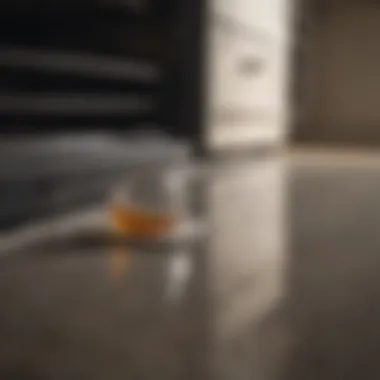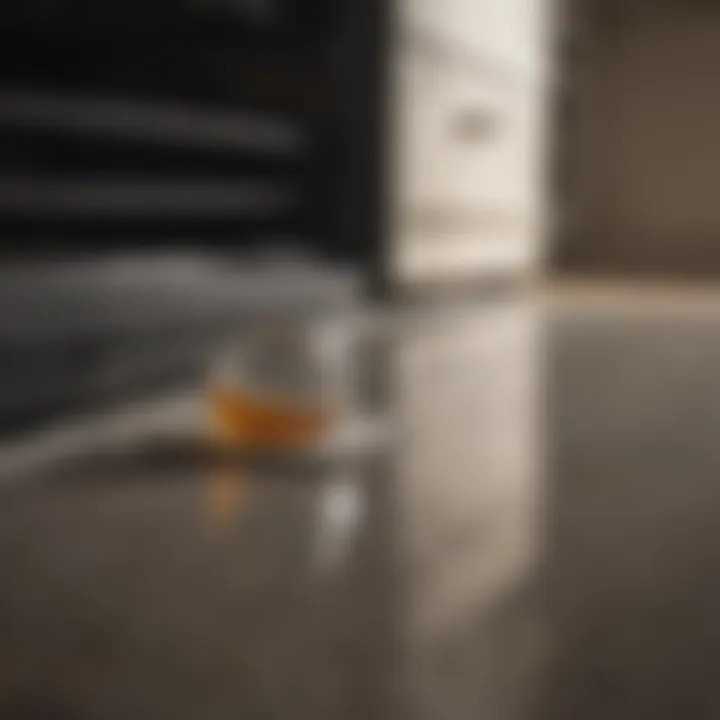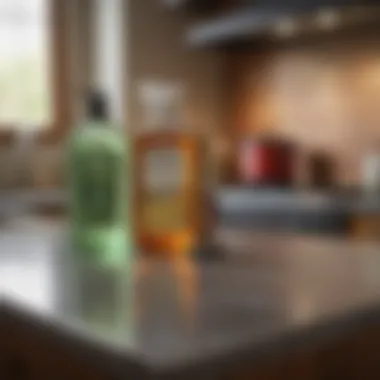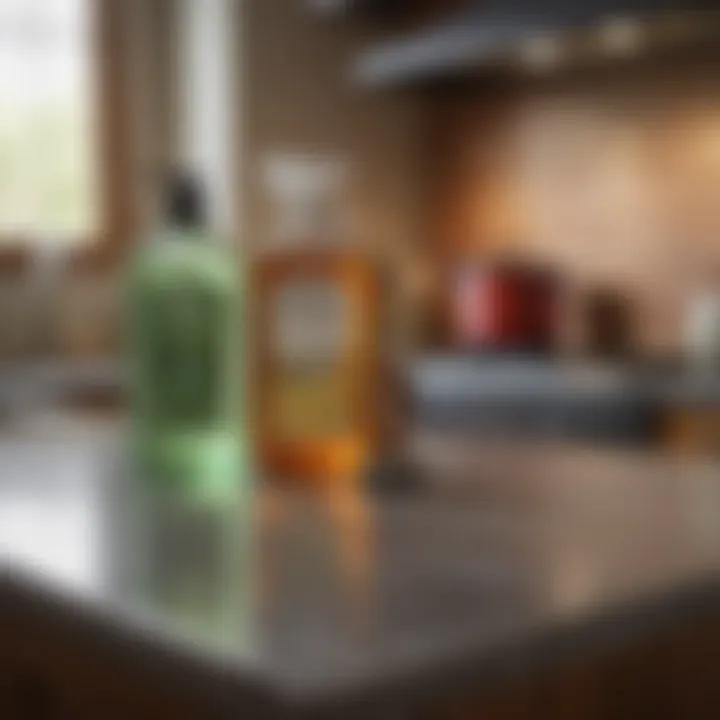Effective Oven Cleaning with Vinegar and Baking Soda


Intro
Cleaning an oven isn't usually on anyone's list of favorite chores. It's often seen as a daunting task, filled with stubborn stains and unpleasant odors. However, what if there was a way to tackle this cleaning monster using simple household items? Enter vinegar and baking soda, a dynamic duo that has been delighting cleaning enthusiasts for years. Not only are they effective, but they also keep the environment in mind, appealing to those who lean towards eco-friendly living.
In this guide, you'll discover how these common kitchen staples can transform the often tiresome job of cleaning your oven into a more efficient and effective process. The familiarity of vinegar's acidic nature and baking soda's alkaline properties comes into play, creating a powerful reaction that can break down grime and grease. This guide will provide clear, actionable steps tailored to different oven designs, allowing you to customize your cleaning process according to your household’s needs.
By using vinegar and baking soda, you're not just cleaning—you're taking a step towards a healthier home. Instead of relying on chemical-laden cleaners that can be harmful to your family and the environment, you'll use methods that are safe, non-toxic, and surprisingly effective. Let’s dive into the science and strategy behind this cleaning technique.
Prelims to Oven Cleaning
Cleaning an oven may often feel like a daunting task, one that gets pushed to the back burner in the whirlwind of daily life. However, the state of your oven can have more impacts than one might think. Regular oven maintenance is not just about keeping your kitchen looking good; it's about prolonging the life of the appliance and ensuring that your culinary creations are safe and delectable. A clean oven fosters better air quality and enhances the taste of your meals, relieving any unpleasant flavors that might linger from previous dishes.
Importance of Regular Oven Maintenance
Think of your oven as the heart of your kitchen—it needs care to function optimally. Neglecting to clean it can lead to grease buildup, which not only affects cooking times but could also potentially turn into a fire hazard. Regular cleaning reduces the risk of rancid smells and unpleasant taste in your food. Besides enhancing safety, a well-maintained oven operates efficiently. Saving energy not only benefits the environment but also your wallet—after all, who wouldn’t want lower energy bills?
Why Choose Vinegar and Baking Soda?
When it comes to choosing cleaning agents, vinegar and baking soda have gained a solid reputation for being highly effective, easily accessible, and safe for your home environment.
Non-toxic Properties
One of the standout features of vinegar and baking soda is their non-toxic nature. Unlike many commercial cleaners, both these household ingredients are safe around children and pets. This aspect makes them a popular choice for anyone looking to maintain a clean home without exposing family members to harmful chemicals. This natural duo is gentle yet effective at breaking down grime, making it suitable for various surfaces and stains within the oven.
Cost-Effectiveness
From a financial perspective, vinegar and baking soda don't come with the hefty price tags associated with specialized cleaning products. A bottle of vinegar and a box of baking soda can be purchased for just a few bucks, making them a cost-effective solution for oven cleaning. This is particularly appealing for larger households that need to keep things clean without breaking the bank. You can clean not just your oven but also various surfaces around the house, stretching the value of these ingredients that much further.
Accessibility
Another notable benefit of vinegar and baking soda is their accessibility. These ingredients are staples in most grocery stores, and many households even keep them on hand in their pantries. There’s no need for a special trip to the store or worry about running out of a particular cleaning product. This convenience allows you to tackle oven cleaning whenever necessary, without the hassle of searching for hard-to-find items.
"A clean oven is not only essential for safety but also enhances your culinary experience and boosts your home’s ambiance."
With a clearer understanding of the importance of oven maintenance and the advantages of using vinegar and baking soda, you are now better equipped to bring the sparkle back to your kitchen appliance.
Understanding the Science Behind the Ingredients
Cleanliness often plays an unassuming, yet pivotal role in our daily interactions with our kitchen—a place where we whip up meals and gather with family. Therefore, understanding how the ingredients we employ to cleanse our ovens works is fundamental. Vinegar and baking soda aren't just home remedies; they are mighty, natural forces against grime and grease. Knowing the science behind them helps set expectations for their effectiveness in various situations.
The Role of Acidity in Cleaning
When we talk about vinegar, it’s essential to recognize its acidic nature, which is notably strong due to acetic acid. This characteristic grants it the ability to break down deposits, making it a formidable foe against mineral buildup and tough stains. Although it may not be a wizard’s potion, the chemistry is simple yet effective.
- Acids and Grease: The acidic environment helps in breaking down grease. This reaction is crucial when cleaning ovens, where fats tend to accumulate in stubborn patches.
- Deodorizing Properties: Besides cleaning, vinegar neutralizes odors, which can come as an added advantage. It turns out, when you toss a few tablespoons in the oven during cleaning, it helps remove lingering food smells.
- Safely Dissolving Build-Up: The role of acidity is akin to a double-edged sword. It dissolves build-up without the harsh chemicals found in commercial cleaners. This offers cleaner air while preserving the kitchen space’s integrity.
In summary, the acid found in vinegar isn't merely for salad dressing; it's a cleaning secret waiting to be used against the nastiest oven stains.
Baking Soda: The Power of Abrasion
Unlike vinegar's acidic properties, baking soda showcases an alluring abrasiveness, which is key to its effectiveness. When mixed with a bit of water, it creates a thick paste that stands up against stuck crumbs and charred remnants.
- Gentle Yet Effective: Baking soda offers a non-scratching alternative compared to harsher abrasive cleaners. It’s like having a tiny army of particles that gently scrubs off grime without leaving a mark on the oven's surface.
- Reaction with Acids: When baking soda encounters acids, including vinegar, a fizzy reaction ensues. This not only contributes to the lifting of stubborn stains but also assists in the material breakdown—in a way, it’s their chemistry that works in tandem to clean efficiently.
- Deodorizing Agent: Moreover, the alkaline nature of baking soda means it doesn’t just mask odors; it neutralizes them. Your oven not only sparkles but also smells fresh, embodying a thorough cleanse.
These two humble ingredients, when brought together, create a cleaning powerhouse. They represent a synthesis of nature and science, ensuring that while you are tackling the challenges of oven cleanliness, you are doing so with methods that are not just effective but also aligned with eco-conscious practices. Understanding their distinct properties allows one to appreciate how a simple combination can lead to profound cleanliness—all in the name of a sparkling oven.
Preparing Your Cleaning Supplies
When it comes to cleaning your oven effectively with vinegar and baking soda, preparing your cleaning supplies is a cornerstone of success. Having your tools and ingredients ready not only streamlines the process but also ensures you're well-equipped to tackle even the toughest messes. This preparation minimizes frustration and helps you achieve stellar results. It’s like having your ducks in a row before you dive into a project.
Being systematic about your supplies sets the tone for an efficient cleaning session. You wouldn't go out for a road trip without checking your gas tank, right? Likewise, having everything you need within arm's reach makes the task less daunting and more manageable.
Essential Tools for the Task
Spray Bottle
The spray bottle is an unsung hero in the cleaning arsenal. Its primary role is to make the application of vinegar straightforward and precise. Vinegar, as many know, packs quite the punch when it comes to cutting through grime, but having a way to dispense it effectively is key. The main characteristic that makes a spray bottle so useful is its ability to mist, allowing for an even distribution over surfaces. This helps in targeting specific spots without drenching everything around it.


A unique feature of spray bottles, particularly those with adjustable nozzles, is the option to switch from fine mist to a direct stream. This versatility makes it easy to tailor the application based on the level of stubbornness of the residue you're dealing with. Nonetheless, make sure to keep it clean, as residue from previous cleaners can interfere with your vinegar application, which may defeat the purpose.
Spatula or Scraper
A spatula or scraper might seem like a simple tool, but it holds significant value in the cleaning process. Its primary task revolves around helping lift stubborn food particles and grime from the oven surface. The critical aspect here is its firmness. A good scraper offers just enough rigidity to dislodge baked-on messes without risking damage to the oven's interior.
What stands out about the spatula is its design. Unlike metal options, silicone spatulas provide a gentler touch, minimizing the risk of scratching non-stick surfaces. However, caution is still advised, as too much pressure can lead to unwanted marks. This tool is beneficial due to its dual-purpose nature: it can both spread cleaning paste and remove debris effectively.
Microfiber Cloths
Microfiber cloths are indispensable when it comes to cleaning. Their unique construction gives them the ability to attract dust and grime like magnets. Unlike regular cloth, which pushes dirt around, microfiber penetrates the surface, ultimately offering a deeper clean. This tool is particularly advantageous in the final stages of cleaning, where you want to wipe away the paste and any remaining gunk.
Another notable characteristic is the soft texture, which ensures that no scratches mar your oven’s finish. You might find various colors and styles available, but make sure you choose non-abrasive ones for this cleaning job. However, don't forget that they require proper care; using fabric softeners in washing can reduce their effectiveness, so a little attention in the laundry will go a long way in maintaining their ability.
Gathering Ingredients
White Vinegar
White vinegar is a powerhouse in many cleaning routines. When it comes to its role in oven cleaning, it's nothing short of essential. One of its defining properties is its natural acidity, which allows it to break down grease and grime effectively. Not only does it deliver a strong cleaning punch, but it also evaporates quickly, adding a fresh scent to your kitchen after use.
What makes white vinegar a popular choice is its accessibility. It's usually found in most households and is quite budget-friendly. The downside? It can have a strong scent, so while you battle dirt, try to ventilate the area by opening windows if possible.
Baking Soda
Baking soda is more than just a baking ingredient; it’s a multifaceted cleaning agent. Its key attribute lies in its ability to scrub and deodorize, making it an effective component in tackling tough stains within your oven. When combined with vinegar, the bubbling reaction can be mesmerizing and highly effective at dislodging stubborn residues.
As a cleaning choice, baking soda is favored not only for its cleaning prowess but also for its non-toxic nature. Unlike harsh commercial cleaners, it poses no harm to pets or children in your home. On the flip side, it does require a bit of elbow grease when scrubbing, so prepare for a workout!
Additional Optional Ingredients
While vinegar and baking soda are powerhouses, consider adding some other ingredients to elevate your cleaning game. Lemon juice, for instance, can be mixed in to offer delightful fragrance and additional cleaning properties due to its citric acid. Essential oils are another excellent choice, lending pleasant scents while showcasing antimicrobial qualities.
The main characteristic of these optional ingredients is their versatility. Incorporating them can enhance the overall effectiveness of your cleaning efforts. However, caution is needed with essential oils—using them in moderation ensures that your oven doesn’t end up with a strong residual scent.
Step-by-Step Cleaning Process
Clean ovens are not just a matter of aesthetics; they contribute to better cooking results and healthier living environments. A step-by-step cleaning process serves as a roadmap for homeowners looking to tackle the buildup of grime and grease that often accumulates in their ovens. Having a clear plan not only makes the task more manageable but also helps ensure that no corner gets overlooked during the cleaning process.
Clean ovens can enhance the flavors of your meals while preventing unpleasant odors from altering your culinary creations. The logical flow of this cleaning method, which relies on easily accessible ingredients like vinegar and baking soda, encourages sustainability and environmental consciousness among users. This guide highlights the ease and effectiveness of using these humble substances, demystifying the process and allowing anyone to achieve a cleaner oven with minimal hassle.
Initial Preparations
Safety Precautions
Before diving into the cleaning process, ensuring safety is of utmost importance. Using natural cleaning products like vinegar and baking soda lowers the risk of chemical burns or respiratory issues associated with harsh commercial cleaners. It’s vital to wear gloves to protect your skin from any irritation that may arise from scrubbing or handling the paste created. Moreover, good ventilation in the kitchen is crucial. Keeping a window open or turning on a fan ensures that any fumes are quickly dissipated, creating a safer cleaning environment.
The hands-on approach to cleaning means safety must come first. This precaution helps you avoid mishaps, making the process smoother.
Removing Oven Racks
Taking the time to remove the oven racks before starting the cleaning process is essential. This step not only grants better access to the interior surfaces but also allows you to clean the racks separately, ensuring a more thorough overall job. By removing these components, you're avoiding smudges on places that are often hard to reach if left in place. The act of removing racks might seem trivial, but it contributes significantly to the effectiveness of your cleaning endeavors.
This preparation helps free any built-up residues that could otherwise become stubborn if they remain untreated with the cleaning paste.
Creating the Cleaning Paste
Ratio of Ingredients
Creating the cleaning paste is where the magic happens. The recommended ratio is typically three parts baking soda to one part vinegar. This combination activates the cleaning properties of both ingredients, allowing them to work together effectively. The creamy paste that emerges provides the right consistency to adhere to the oven surfaces without dripping, avoiding unnecessary messes.
The balance you strike in this ratio can determine how well the paste works on different types of grime. Too much vinegar can make it overly runny, while too little might not provide the desired cleaning power. Achieving the right mix is a crucial step in ensuring effective oven management.
Mixing Techniques
To create a paste that clings to vertical surfaces, start by combining baking soda in a bowl and gradually add vinegar. Stir gently to combine until you form a smooth, creamy consistency. Avoid vigorous mixing; instead, blend slowly to keep the fizzing reaction controllable. The more blended it is, the smoother it will apply as you scrub in the oven later. It's this careful balance of texture and composition that makes mixing technique critical for efficient cleaning.
Application of the Paste
Targeting Stubborn Areas


Identify areas with tough buildup or stubborn stains and generously apply the cleaning paste to those spots. The paste should be thick enough to cling rather than run off. Targeting these areas with intention ensures that you spend less effort scrubbing later on, as the paste works its magic during the waiting period.
By focusing on specific problem areas, the cleaning process becomes more efficient and effective, saving you time and frustration. This targeted approach reduces the need for excessive scrubbing, which can be tiresome in the long run.
Time for the Paste to Work
After applying the paste to stubborn stains, let it sit for at least 30 minutes—though leaving it for several hours can yield even better results, particularly on deeply embedded grime and grease. This waiting period allows the acidic vinegar to break down the tougher residues while baking soda works to absorb any lingering odors in the process.
The importance of patience in this step cannot be overstated. Although waiting might seem tedious, it ultimately pays off with less elbow grease needed during the scrubbing phase.
The Vinegar Spray Technique
Application Method
Once the paste has settled into the targeted areas, it’s time to incorporate the vinegar spray. Filling a spray bottle with vinegar and lightly spritzing the surfaces where the paste has been applied can activate the cleaning reaction once again. This dual application of paste and spray amplifies the cleaning effect, enhancing the overall efficiency of the process.
Not only does this spraying method aid in lifting away the grime, but it also refreshes the paste, helping to keep it moist and active for longer durations, which is essential for stubborn dirt.
Observing Reactions
As the vinegar interacts with the baking soda, you’ll notice bubbling and fizzing. This is perfectly natural; it's the chemical reaction at work. Watching this change can give you satisfaction, indicating that the paste is indeed breaking down the grime. The fizzing also serves a practical purpose, gently agitating particles of dirt, making them easier to wipe away later.
Observing these reactions adds a compelling visual element to the cleaning process, serving as a live demonstration of chemistry helping you clean.
Scrubbing the Oven Interior
Recommended Tools
For effective cleaning, choose the right tools. A non-abrasive scrub brush or a sponge works wonders without scratching the oven’s surfaces. Microfiber cloths are also excellent for this process due to their ability to trap dust and grime.
Using the recommended tools lets you clean efficiently while keeping the integrity of your oven intact. Each tool serves its purpose well, allowing for a streamlined cleaning experience.
Technique for Effective Cleaning
When scrubbing, use gentle circular motions to dislodge dirt without risking any damage to the oven’s surfaces. Pay extra attention to corners and crevices where grime tends to gather. The aim here isn’t to rush, but to ensure that every inch is treated with care.
Employing this technique not only enhances the overall appearance of the oven but also helps in preventing future buildup.
Finishing Touches
Residue Removal
Post scrubbing, it’s time to remove any leftover paste and residue. This can be done effectively with a damp sponge or cloth, ensuring that all remnants of the cleaning solution are wiped away completely. Leaving any paste behind might lead to odd smells or even attract dirt later on.
The fine details of residue removal are integral to ensuring that you enjoy a perfectly clean oven that looks as good as new.
Reinstalling Oven Racks
Finally, once everything is clean, return the racks with care. Make sure they’re dry and free of any cleaning residue before placing them back in the oven. This step completes the cleaning process, marking the transition from mess to cleanliness. The final touches can make or break the entire cleaning experience–making sure that everything feels fresh and ready for its next big task in the kitchen.
In summary, undertaking a step-by-step cleaning process not only makes the task less daunting but ensures that your oven remains in prime condition, ready for any culinary adventure that comes its way.
Post-Cleaning Care
After dedicating time and effort to clean your oven with vinegar and baking soda, it's crucial to perform some post-cleaning care to maintain that fresh cleanliness. Not only does this ensure your hard work lasts longer, but it also enhances the efficiency and safety of your appliance. The right post-cleaning steps can keep your oven looking sharp and functioning well for many meals to come.
Maintenance Tips for Long-Lasting Cleanliness
To keep your oven pristine after a thorough cleaning, consider these maintenance tips:
- Wipe Down Regularly: Make it a habit to wipe the interior surfaces after each use. This simple act removes spills and prevents built-up grime.
- Use a Liner: A liner for the bottom of your oven can catch drips and crumbs. It saves you from scrubbing the floor of the oven too often.
- Routine Checkups: Every couple of months, do a quick assessment. Look for any stains or particles that need attention. Address these before they become stubborn.
- Watch for Alerts: If your oven has any warning lights or beeping sounds, pay attention. These can signal problems that require immediate action.
By implementing these basic habits, the longevity of your oven's cleanliness increases significantly, adding to your kitchen's overall appeal.
Storing Leftover Cleaning Solutions
After cleaning, you may find yourself with some leftover cleaning solutions. Knowing how to store them properly is crucial:


- Use Airtight Containers: Store any remaining vinegar and baking soda mix in a tightly sealed container. This prevents contamination and prolongs its effectiveness.
- Label Clearly: Mark containers with the contents and date. This helps you remember what’s inside and when it was made.
- Keep Away from Heat Sources: Store these mixtures in a cool, dark place, avoiding exposure to heat that could affect their potency.
Empty containers should also be clean and dry before storage to prevent any lingering odors or reactions with the remaining substances.
Making sure your leftover cleaning solutions are stored properly can save time and effort in future cleaning endeavors!
The Benefits of Natural Cleaning Products
Using natural cleaning products has become more than a trend; it is increasingly recognized as a vital part of maintaining a healthy home environment. This section digs into how opting for natural substances like vinegar and baking soda offers substantial gains—not just in cleaning effectiveness, but also in health and environmental stewardship.
Health Advantages
One compelling reason to switch to natural cleaning solutions is the immediate benefit to health. Many commercial cleaners contain harsh chemicals that can irritate the skin, eyes, and respiratory system. In fact, prolonged exposure to these substances can lead to serious health issues. In contrast, vinegar and baking soda stand out as safe alternatives. Their non-toxic nature means they can be used around children and pets without significant worry.
Also, vinegar, being a mild acid, has antiseptic properties. It does a decent job of killing most bacteria and some viruses. This makes it practical for maintaining a sanitized kitchen without needing to introduce potentially harmful chemicals into your living space.
"Embracing natural products not only protects your living space but also contributes to your overall well-being."
The simple act of cleaning your oven with such ingredients can reduce allergens and irritants in the air. So, not only do you achieve a spick-and-span oven, but you do so in a way that promotes better indoor air quality. Consider this: with cleaner air circulating in your home, you’re less likely to experience allergic reactions or respiratory challenges.
Environmental Impact
On the environmental front, the benefits of using vinegar and baking soda are quite impactful. For one thing, these two ingredients are often easier to find than their chemical-laden counterparts. No need for excessive packaging or the processing associated with the production of synthetic cleaners. This minimalism is a significant boon for reducing waste.
Furthermore, both baking soda and vinegar break down easily in nature. They pose little risk to wildlife or ecosystems when washed away down the drain. By choosing natural options, you are actively participating in a cycle that supports overall ecological balance.
The production of conventional cleaning products often involves toxic chemicals that, once discarded, can lead to environmental contamination. This raises concerns about the health of water supplies and wildlife. Therefore, making the switch to natural cleaners aligns your cleaning routine with a more sustainable lifestyle. With this in mind, it’s not just about keeping your oven clean—it's about protecting the world we inhabit for future generations.
In summary, the advantages of using natural cleaning products like vinegar and baking soda extend far beyond simple cleaning efficacy. They promote a healthier living space, safeguard your well-being, and protect the environment, demonstrating that small choices can lead to significant positive consequences.
Common Issues and Solutions
When it comes to cleaning your oven, everyone runs into a few bumps along the road. This section shines a light on common challenges you might face and offers practical solutions to keep your cleaning process on track. Issues like persistent stains or lingering odors might sound minor, but they can be quite frustrating. Understanding how to tackle these matters not only enhances the cleaning process but also helps maintain an inviting kitchen atmosphere.
Persistent Stains
Persistent stains are the kind of headache when cleaning the oven that many dread. These stains often come from spills that have baked onto the surfaces, requiring a bit more elbow grease. The good news is that vinegar and baking soda work wonders in this regard. One effective method is to apply a thicker paste made with more baking soda and less vinegar directly on the stain. Let it sit for at least 30 minutes, giving the mixture a chance to do its magic, breaking down the stubborn residue.
Consider these points when combating persistent stains:
- Prevention is Key: Using a splatter guard or lining the bottom of the oven with foil can reduce the chances of tough stains forming in the first place.
- Targeted Application: Focus on one stain at a time rather than tackling the entire oven. This allows for more effective cleaning and less frustration.
- Right Tools: Utilize a non-abrasive scrub pad to avoid scratching your oven's surface while scrubbing away those pesky stains.
A mix of patience and proper techniques can turn a seemingly hopeless task into a simple win.
Unpleasant Odors
Unpleasant odors can linger long after a thorough clean, particularly if food has been left to char or spill inside the oven. This problem can deter anyone from using the appliance. Luckily, vinegar can act like a natural deodorizer. Spray it generously inside the oven after cleaning, and the smell will dissipate over time. Making a simple deodorizing solution with water and vinegar can also help when used in combination with your regular cleaning routine.
Keep these tips in mind for neutralizing those unwelcome scents:
- Regular Maintenance: Additional periodic cleanings can prevent odors from building up. Consider a monthly deep-cleaning schedule.
- Air It Out: After cleaning, leave the oven door open for a while to let fresh air circulate.
- Essential Oils: For an enjoyable smell, consider placing a small dish of water with a few drops of your favorite essential oil in the oven and heating it for about 15 minutes; this helps mask any residual odors.
"Using natural ingredients like vinegar not only works wonders for cleaning but also keeps those noxious smells at bay."
By identifying and effectively addressing these common issues, you can ensure that your oven not only looks clean but also smells fresh. Tackling persistent stains and unpleasant odors with the right strategies will give you the confidence to maintain your kitchen as a welcoming space for family and friends.
Epilogue
Cleaning your oven isn’t just about keeping up appearances; it’s about ensuring a safe and healthy cooking environment. Throughout this article, we’ve explored the remarkable method of using vinegar and baking soda for oven cleaning, emphasizing the sheer effectiveness of these common household items. The process is not only efficient but also highlights the benefits of natural cleaning agents that many householders might overlook.
Recap of the Cleaning Method
To distill the steps discussed earlier:
- Preparation: Gather all necessary tools such as a spray bottle, spatula, and microfiber cloths, along with our star ingredients: white vinegar and baking soda.
- Creating the Paste: Mix baking soda and water to a paste-like consistency. This mixture is the backbone of our cleaning efforts.
- Application: Spread the paste across the oven surfaces, focusing on areas with stubborn grime. Allowing it to sit will let the baking soda work its magic.
- Vinegar Spray: A swift spritz of vinegar over the paste causes a fizzy reaction, further loosening dirt and stains.
- Scrubbing: After the paste is done working, you can apply some elbow grease, scrubbing the interior with the recommended tools.
- Finishing Touches: Finally, wipe down any residue and reinstall the oven racks, leaving your oven sparkling clean.
By following these steps, you can effectively tackle the grime that accumulates over time, ensuring your oven remains a safe place to prepare meals. Vowing to maintain this cleaning routine can also save you from tougher scrubs in the future.
Encouragement for Continued Exploration of Natural Cleaners
Venturing into the world of natural cleaning solutions goes beyond just your oven. The benefits steeply rise when you consider other areas of household cleaning. By opting for natural ingredients like vinegar and baking soda, you are not only engaging in a cost-effective practice but also making a conscious effort towards a healthier living space.
Embracing natural practices demonstrates a responsible choice for both your health and the environment. Whether it’s using lemon juice for a fresh scent or essential oils for added antimicrobial properties, there’s a vast array of options to further explore.
Remember: Natural does not mean less effective; it can be just as powerful and much safer. Keep digging into these alternatives, and you’ll find that they can simplify your life while maintaining both your space and the planet in harmony.







